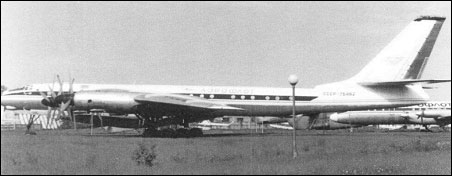 |
Tupolev Tu-1161958 |  |
| AIRLINER | Virtual Aircraft Museum / USSR / Russia / Tupolev |
 |
The Soviet government had planned for several years that the General Secretary of the Communist Party and Premier of the Soviet Union, Nikita Khrushchev, should address the United Nations General Assembly. As a matter of national prestige, he had to travel on a Soviet airliner. When this matter first arose, in the mid-1950s, the Soviet Union had no medium- or long-range aircraft in commercial service. Although the Tu-104 was shortly to enter service, it was not considered suitable because of its relatively short range. The -114 was in the early stages of design, but whether it would be operational before the end of the decade was difficult to determine. The Soviet Union had, of course, the remarkable Tu-95, but the nation's leader could not travel in a strategic bomber - or could he? Tupolev was called in. Nikolai Bazenkov was diverted from other duties to prepare a passenger version of the Tu-95. Two aircraft were taken from the production line at Kuibyshev. No armaments were fitted, and all military equipment was removed. With the original airframe of the Tu-95, a passenger compartment was installed behind the wing spar; it consisted of a pressurised cabin with two sections, each of which could accommodate twenty passengers in VIP luxury. A kitchen, toilet and service room were also installed. A fitted stairs was installed so passengers could board and disembark without a need for special airport equipment. Although the work began only in mid-1957, the Tu-116, which was sometimes called the Tu-114D, was airborne by spring 1958. Usually, the 'D' suffix in an aircraft designation represented 'Dalnii' (long distance), but this time it stood for 'Diplomaticheskii' (diplomatic). In April 1958, the prototype Tu-116, Air Force Number 7801, a number probably derived from its manufacturer's block and line number, made a high-altitude, long-distance trial flight to demonstrate its ability for the task. Flying at levels between 10,000m and 12,200m, it flew non-stop from Moscow to Irkutsk and back to Moscow, covering 8,500km at an average speed of 800km/h. After landing, it was calculated still to have fuel for another 1,500 to 2,000km. The second aircraft was intended as a reserve in the event of a problem with the first, but neither were needed. Instead, Khrushchev flew to the New York headquarters of the United Nations Assembly in the prototype Tu-114. Never intended for normal commercial service, the two Tu-116s were little used. Originally painted in military marks (7801 and 7802), one aircraft was later given the civilian registration SSSR-76462, and is now preserved in the Ulyanovsk Museum of Civil Aviation.
|  COMPANY PROFILE | |||||||||||||||||||||||||||||||||||||||||||||
 |

|

